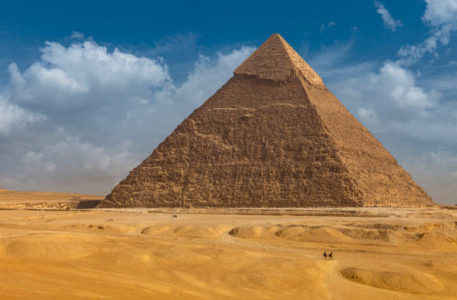Researcher claims discovery of historical figure's tomb beneath ancient site
By
Gian T
- Replies 11
A recent claim by a researcher is sparking curiosity and debate, with suggestions that a religious historical figure’s final resting place may not be where it has long been believed.
The theory challenges centuries of tradition and points to a surprising location beneath one of the world’s most iconic ancient structures.
While details remain speculative, the idea has already ignited discussion among scholars and the public.
Dr Paul Warner, a British anthropologist, suggested that a secret chamber, which also houses the legendary Ark of the Covenant, is sealed off by a massive stone block deep within the Great Pyramid of Giza.
The Ark, a gold-plated wooden chest revered in Christian and Jewish lore, is believed to have contained the stone tablets inscribed with the Ten Commandments God gave to Moses.
Warner's 'evidence' has been presented to the Egyptian authorities, who, if reports are to be believed, are thrilled by the prospect of such a 'scientific revolution.'
The anthropologist's decade-long research has led him to focus on a specific area known as the Southern Passageway.
He claimed that his surveys had detected man-made structures beyond the tunnel's final stone block, suggesting a hidden space awaiting discovery.
Photos and video footage, allegedly taken from the pyramid's most secluded and original parts, carved directly from the bedrock, support his claims.
Warner's approach to identifying this location beneath the Great Pyramid involved an intricate cross-referencing of the three Abrahamic religions—Judaism, Christianity, and Islam—and their sacred texts, alongside ancient Mesopotamian clay tablets.
His conclusion is that various biblical and Quranic sites, such as Mount Sinai, the Mountain of Israel, the Mount of Olives, Mount Zion, and the Mountain of Light, are all references to the Great Pyramid itself.
Warner even suggests that this is the true location where Jesus delivered the 'Sermon on the Mount.'
Warner did not underestimate the implications of his discovery; he believed that unveiling the truth could bring peace to the Middle East.
His next step, he argued, should be to remove the final stone at the end of the Southern Passageway to reveal its secrets.
However, Warner's journey has not been without its share of drama. He has found himself embroiled in a dispute with Egypt's antiquities department.
Warner alleged that he was appointed as a consultant to the Scan Pyramids Mission, an international scientific team using advanced techniques to examine the pyramid's interior.
He claimed that an agreement was made to scan the area beyond the passageway's final block in exchange for his data.
However, he accuses the Egyptian authorities of reneging on their promise.
The dispute has escalated to the point where Warner is now seeking the intervention of the Prime Minister of Lebanon to prevent an 'international row.'
He has openly criticised Zahi Hawass, Egypt's former Minister of Tourism and Antiquities, labelling him 'an obstacle to progress.'
Despite claiming to have the support of Egypt's highest authorities, Warner admits facing 'violent opposition from the old guard.'
This story, initially reported by The Sun, has captured the imagination of many worldwide.
Could one of the greatest mysteries of religious history be on the verge of being solved?
Or is this another wishful thinking and misinterpretation of ancient symbols and texts?
Credit: YouTube

What do you think about Dr Warner's claims? Is there a possibility that he's onto something, or is this just another wild goose chase? Share your thoughts and opinions in the comments below.
The theory challenges centuries of tradition and points to a surprising location beneath one of the world’s most iconic ancient structures.
While details remain speculative, the idea has already ignited discussion among scholars and the public.
Dr Paul Warner, a British anthropologist, suggested that a secret chamber, which also houses the legendary Ark of the Covenant, is sealed off by a massive stone block deep within the Great Pyramid of Giza.
The Ark, a gold-plated wooden chest revered in Christian and Jewish lore, is believed to have contained the stone tablets inscribed with the Ten Commandments God gave to Moses.
Warner's 'evidence' has been presented to the Egyptian authorities, who, if reports are to be believed, are thrilled by the prospect of such a 'scientific revolution.'
The anthropologist's decade-long research has led him to focus on a specific area known as the Southern Passageway.
He claimed that his surveys had detected man-made structures beyond the tunnel's final stone block, suggesting a hidden space awaiting discovery.
Photos and video footage, allegedly taken from the pyramid's most secluded and original parts, carved directly from the bedrock, support his claims.
Warner's approach to identifying this location beneath the Great Pyramid involved an intricate cross-referencing of the three Abrahamic religions—Judaism, Christianity, and Islam—and their sacred texts, alongside ancient Mesopotamian clay tablets.
His conclusion is that various biblical and Quranic sites, such as Mount Sinai, the Mountain of Israel, the Mount of Olives, Mount Zion, and the Mountain of Light, are all references to the Great Pyramid itself.
Warner even suggests that this is the true location where Jesus delivered the 'Sermon on the Mount.'
Warner did not underestimate the implications of his discovery; he believed that unveiling the truth could bring peace to the Middle East.
His next step, he argued, should be to remove the final stone at the end of the Southern Passageway to reveal its secrets.
However, Warner's journey has not been without its share of drama. He has found himself embroiled in a dispute with Egypt's antiquities department.
Warner alleged that he was appointed as a consultant to the Scan Pyramids Mission, an international scientific team using advanced techniques to examine the pyramid's interior.
He claimed that an agreement was made to scan the area beyond the passageway's final block in exchange for his data.
However, he accuses the Egyptian authorities of reneging on their promise.
The dispute has escalated to the point where Warner is now seeking the intervention of the Prime Minister of Lebanon to prevent an 'international row.'
Despite claiming to have the support of Egypt's highest authorities, Warner admits facing 'violent opposition from the old guard.'
This story, initially reported by The Sun, has captured the imagination of many worldwide.
Could one of the greatest mysteries of religious history be on the verge of being solved?
Or is this another wishful thinking and misinterpretation of ancient symbols and texts?
Credit: YouTube
Key Takeaways
- A British anthropologist has claimed to have located the tomb of Jesus Christ beneath the Great Pyramid of Giza, alongside the Ark of the Covenant.
- Dr Paul Warner has presented his 'evidence' to the Egyptian authorities and used a combination of religious texts and ancient Mesopotamian writings for his claim.
- Warner's discovery has caused a dispute with Egypt's antiquities department, with him accusing them of not following through on a deal to scan the area further.
- The researcher suggests that revealing what is beyond the final stone block of the Southern Passageway could potentially bring peace to the Middle East, although his claims are met with scepticism and opposition.
Last edited:








